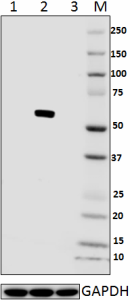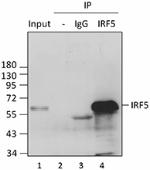- Clone
- 11F4A09 (See other available formats)
- Regulatory Status
- RUO
- Other Names
- Interferon regulatory factor 5 (IRF-5)
- Isotype
- Mouse IgG2b, κ
- Ave. Rating
- Submit a Review
- Product Citations
- publications

-

Total lysates (15 µg protein) from 293E (lane 1), THP-1 (lane 2) and Raw264.7 (lane 3) were resolved by electrophoresis (4-12% Bis-Tris gel), transferred to nitrocellulose, and probed with 1:2500 diluted (0.2 µg/mL) purified anti-IRF5 antibody (upper). Proteins were visualized using an HRP goat anti-mouse-IgG secondary antibody (Cat. No. 405306) or HRP Donkey anti-rabbit IgG Antibody (Cat. No. 406401) for GAPDH and chemiluminescence detection. GAPDH (poly6314, Cat. No. 631401) antibody was used as a loading control (lower). Lane M: MW ladder. -

Immunoprecipitation of IRF5 from THP-1 cell extracts. Lane 1 is 5% input. Immunoprecipitation was performed using protein G resins only (lane 2), mouse IgG isotype control (lane 3), and anti-IRF5 antibody (clone 11F4A09, lane 4). Western blot was performed using anti-IRF5 antibody (clone 11F4A09).
| Cat # | Size | Price | Quantity Check Availability | Save | ||
|---|---|---|---|---|---|---|
| 652601 | 25 µg | £101 | ||||
| 652602 | 100 µg | £221 | ||||
IRF-5 is a transcription factor belonging to the interferon regulatory factor family. It controls induction of type I IFN genes as well as inflammatory cytokines and chemokines through TLRs and the MyD88-TRAF6 pathway. Several genetic variations of IRF-5 have been reported as a risk factor of Systemic lupus erythematosus (SLE), which is caused by excess IFNα induction.
Product DetailsProduct Details
- Verified Reactivity
- Human
- Antibody Type
- Monoclonal
- Host Species
- Mouse
- Immunogen
- Partial human IRF-5 recombinant protein (176-240 aa).
- Formulation
-
This antibody is provided in phosphate-buffered solution, pH 7.2, containing 0.09% sodium azide.
Previous lots of this product may have been formulated with 0.1% or 0.05% NaN3 instead of 0.09% NaN3. For further information please contact BioLegend Technical Support or Customer Service. - Concentration
- 0.5 mg/ml
- Storage & Handling
- Upon receipt, store undiluted between 2°C and 8°C.
- Application
-
WB - Quality tested
IP - Verified - Recommended Usage
-
Each lot of this antibody is quality control tested by Western blotting. For Western blotting, the suggested use of this reagent is 0.2 - 1.0 µg per ml. For immunoprecipitation, the suggested use of this reagent is 2-10 µg per ml. It is recommended that the reagent be titrated for optimal performance for each application.
- Application Notes
-
Internal testing suggests this clone is not suitable for intracellular flow cytometry.
- Product Citations
-
- RRID
-
AB_2561469 (BioLegend Cat. No. 652601)
AB_2561469 (BioLegend Cat. No. 652602)
Antigen Details
- Structure
- 498 aa with predicted molecular weight of 56 kD. The protein contains a DNA binding domain (IRF tryptophan pentad repeat) and a poly-Glutamate region.
- Distribution
-
Shuttles between the nucleus and the cytoplasm.
- Function
- The transcription factor IRF-5 participates in the virus-mediated activation of interferon and regulates gene expression induced by cell growth, differentiation, and apoptosis.
- Interaction
- IKKα phosphorylates IRF-5 and induces formation of IRF-5 dimers. TRAF6 mediates K63-linked ubiquitination of IRF-5, required for nuclear translocation of IRF-5 and regulation of target genes. IRF-5 assemblies with CBP/p300 to initiate transcription.
- Cell Type
- Dendritic cells
- Biology Area
- Cell Biology, Immunology, Innate Immunity, Signal Transduction, Transcription Factors
- Antigen References
-
1. Balkhi MY, et al. 2010. Cell. Signal. 1:117.
2. Balkhi MY, et al. 2008. Mol. Cell. Biol. 28:7296.
3. Salloum R and Niewold TB. 2011. Transl. Res. 157:326.
4. Barnes BJ, et al. 2003. J. Biol. Chem. 278:16630.
5. Rullo OJ, et al. 2010. Ann. Rheum. Dis. 69:611. - Gene ID
- 3663 View all products for this Gene ID
- UniProt
- View information about IRF5 on UniProt.org
Related Pages & Pathways
Pages
Other Formats
View All IRF5 Reagents Request Custom Conjugation| Description | Clone | Applications |
|---|---|---|
| Purified anti-IRF5 | 11F4A09 | WB,IP |
Compare Data Across All Formats
This data display is provided for general comparisons between formats.
Your actual data may vary due to variations in samples, target cells, instruments and their settings, staining conditions, and other factors.
If you need assistance with selecting the best format contact our expert technical support team.
 Login / Register
Login / Register 









Follow Us